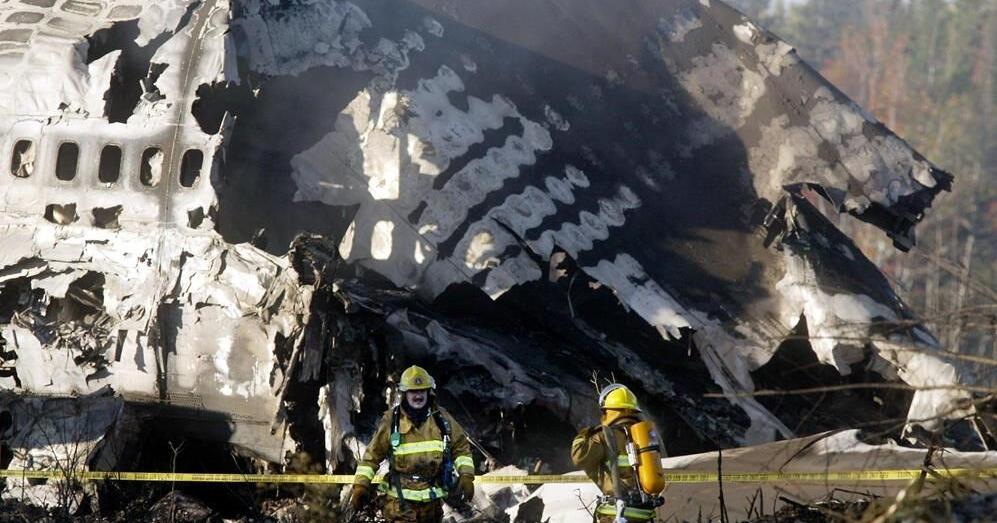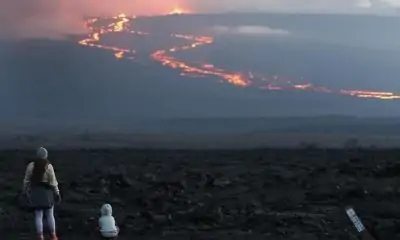HALIFAX – The deadly crash of an MK Airlines cargo plane in Halifax on Oct. 14, 2004, heightened concerns about crew fatigue and inadequate training, but 20 years later, key safety improvements have yet to be made.
Seven crew members — David Lamb, Michael Thornycroft, Gary Keogh, Steven Hooper, Peter Launder, Mario Zahn and Christopher Strydom — died in the crash. Thornycroft was from South Africa, while Zahn was a dual German-South African citizen and the remaining crew were from Zimbabwe.
Their names are on a granite memorial at the site — a wooded area just beyond the airport’s boundary fence — where the fuel-laden Boeing 747 crashed during takeoff, breaking into pieces and lighting up the early morning sky.
Seconds earlier, the heavily loaded flight had struggled to get off the runway, and as a result its tail — which had dragged along the concrete in a shower of sparks — struck a berm at the end of the runway, snapping off and preventing any hope of recovery.
Ray Wagner’s Halifax law office worked with a Toronto law firm representing six of the victims’ families in a lawsuit against the airline, the Halifax airport, a firm that provided training and a company that loaded the aircraft. Wagner said he recalls the lasting trauma on the families. In Nova Scotia Supreme Court records, there are 35 people listed as family members affected by the disaster, including parents, children, siblings and spouses.
“I lament for the families,” Wagner said in an interview last week. “I lament for the children who lost their fathers, and there were a lot of children,” he added.
But he is also concerned about whether safety lessons have been learned and fully implemented. “Did it cause them (the defendants in the lawsuit) to really change their behaviours? Do they really change their practices to ensure that it doesn’t happen again?”
Mike Kruger, former chief executive of MK Airlines — which went out of business in 2010 — did not respond to emails seeking comment on the anniversary. Before the Nova Scotia court, MK denied shortcomings in its safety practices.
Initially, according to a report by the Transportation Safety Board of Canada, the disaster seemed to be simple human error. In 2005, investigators pointed to an incorrect throttle setting that left the plane — carrying 350 tonnes of cargo — without the thrust needed to get off the ground.
The crew had recently started using software, known as the Boeing Laptop Tool, which calculated the proper power requirement based on the crew inputting the cargo weight, runway length and weather conditions.
In its analysis, the investigative team found it was possible a crew member using the software inadvertently applied data on cargo weight from the previous flight, which was 110 tonnes lighter, to the Halifax takeoff. As a result, the power setting in Halifax didn’t account for the true weight.
However, according to the TSB report, this error had roots in more than one person’s mistake. “Factors that likely contributed to the incorrect takeoff data being generated and then not being detected before the takeoff attempt were flight crew fatigue … (and) inadequate training on the Boeing Laptop Tool,” the report found.
The TSB concluded the rules about rest used by Ghana-regulated MK Airlines were “one of the least restrictive among the International Civil Aviation Organization’s member states.” MK Airlines allowed shifts of 24.5 hours for three-pilot crews, with up to 18 hours in the air.
By comparison, at the time in Canada, such crews could only work 20 hours, with a maximum of 14 hours in the air.
“There is a reasonable limit to the time a flight crew can remain on duty before acute fatigue begins to induce unacceptable human performance deficiencies,” the report said. And the board’s analysis indicated the crew’s rest levels “would have been at their lowest level of performance because of fatigue,” just as they were trying to use the software in Halifax.
Meanwhile, evidence was unearthed explaining why the crew weren’t proficient with the software. According to the TSB, the company asked crew to “self study” the 46-page manual and there was “little direct training provided.”
In addition, even though the company had three previous accidents, the “regulatory oversight of MK Airlines by the Ghana Civil Aviation Authority was not adequate to detect serious non-conformances to flight and duty times, or ongoing non-adherence to company directions and procedures,” wrote the investigator, who documented how the airline had grown quickly after being founded in Zimbabwe and shifting its corporate location to Ghana.
The Ghanaian authority didn’t respond to an email requesting comment.
The sole recommendation from the report called on Transport Canada to work with its international counterparts to create a takeoff monitoring system that would immediately alert aircraft crew if there were something wrong with power levels during takeoff.
On the TSB website, it says that while Transport Canada agrees “in principle with the recommendation,” no such systems yet exist that are reliable. It adds that the industry is “best placed to take the lead to develop” a system that might have warned the pilots of their impending disaster. The safety board responded that Transport Canada could still push for research in this area, working with other regulators.
Stricter safety rules have been brought in for Canadian pilots of large aircraft since the crash.
For example, as of 2020, airlines were to cap the on-duty period for pilots to between nine and 13 hours depending on the flight’s duration, the number of segments flown that day, and duty start times.
However, Transportation Safety Board placed crew fatigue on its watch list in 2018, and it has remained there since. The board’s website says it wants to see Transport Canada require “fatigue management systems,” where operators go beyond focusing on the hours of rest, and also set in place systems that assess causes of fatigue and make changes to avoid exhaustion.
The Canadian Press asked Transport Canada what it is doing to ensure foreign cargo planes landing in Canada have crew on board who are meeting Canadian standards to prevent fatigue. The department didn’t provide a response by deadline.
Toronto-based lawyer Paul Miller, whose firm launched the lawsuit on behalf of the six families, said he was pleased that by 2007 they each received settlements “in the seven digits.” He said in an interview last week that details cannot be revealed due to a confidentiality agreement.
However, Miller said the legal action was important both for financial and emotional reasons to the families.
“It was really important to give them some explanation of what had happened to their loved ones, and also to get them financial help as the main income earner of each family had been lost in that horrific crash,” he said.
This report by The Canadian Press was first published Oct. 14, 2024.

























